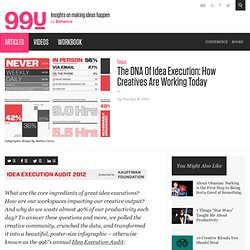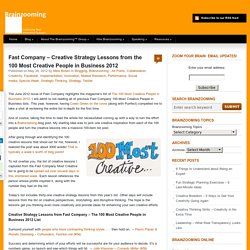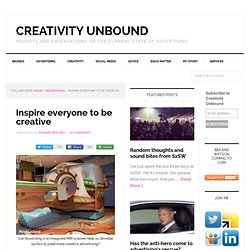

Our 7 Tenets of Future Storyworlds. At the European Broadcast Union (EBU) TV Summit in Copenhagen last week, Transmedia Storyteller Ltd founder and CEO, Robert Pratten, presented our vision for future storyworlds: PERVASIVE – Available on any device, anywhere and at any time.

Blurs real world and fictional world. PERSISTENT – Story evolves even if you’re not engaging with it. Aggregate audience activity and real-world environmental factors shape story development in real time. PARTICIPATORY – Allows audience to interact with story characters, locations, things and each other. The full presentation focused on TV’s role in a much broader non-linear entertainment ecosystem with these seven tenets of future storyworlds applying equally well to any entertainment and news business. A 5-Step Technique for Producing Ideas circa 1939. Cool New Stuff / Clay Shirky: What I Learned About Creativity By Watching Creatives by Piers Fawkes. In this video of his talk at PSFK CONFERENCE NYC, Clay Shirky talks about the work of Interactive Telecommunications Program (ITP) at New York University.
4 Lessons In Creativity From John Cleese. Where ideas and people meet. The DNA Of Idea Execution: How Creatives Are Working Today. What are the core ingredients of great idea executions?

How are our workspaces impacting our creative output? And why do we waste almost 40% of our productivity each day? To answer these questions and more, we polled the creative community, crunched the data, and transformed it into a beautiful, poster-size infographic – otherwise known as the 99U’s annual Idea Execution Audit. Sponsored by the Kauffman Foundation, the Idea Execution Audit premiered at our annual 99U Conference in early May. The results present a fascinating window into our particular productivity struggles ichn the year 2012. 1. Everyone is struggling with how to balance others’ demands with being productive in the things that matter most. It’s not surprising then that while creatives are working 9 hours a day on average, only 5.5 of those hours are truly productive. 2. So what are the time-sucks that are eating up 40% of our day? I’d also wager that the trend toward “open” offices is causing some problems. 3. 4.
Creative Inspirations from the Fast Company 100 Most Creative People in Business List. In its June 2012 issue, Fast Company singled out its list of The 100 Most Creative People in Business 2012.

The list is an intriguing compilation of people and teams applying creativity globally in both expected (entertainment, gaming), and unexpected (kidney donations, insurance) fields. Fast Company – Creative Thinking Ideas from the 100 Most Creative People in Business 2012. Following up the previous post on the June 2012 Fast Company list of The 100 Most Creative People in Business 2012, today’s list of creative thinking ideas from the Fast Company issue focus on disruptive and divergent thinking along with suggestions for enhancing your creative perspective.

As with the other lists in this series, these creative ideas were inspired by the profiles in Fast Company. My intent was to pull a single creative thinking idea or creative lesson from each of the 100 profiles. One interesting note about the Fast Company 100 Most Creative People in Business list is that the numbered rankings don’t seem to have any real meaning. At least I draw that conclusion from how certain groups of people who have similar characteristics (i.e., apps developers, two-person teams, fashion industry leaders, etc.) are given consecutive numbered rankings. That would be just TOO much of a creative coincidence. Disruptive and Constraint-Based Thinking. Fast Company – Creative Strategy Lessons from the 100 Most Creative People in Business 2012. The June 2012 issue of Fast Company highlights the magazine’s list of The 100 Most Creative People in Business 2012.

I will admit to not reading all of previous Fast Company 100 Most Creative People in Business lists. This year, however, having Ceelo Green on the cover (along with Purrfect) compelled me to take a shot at reviewing the entire list in-depth for the first time. And of course, taking the time to read the whole list necessitated coming up with a way to turn the effort into a Brainzooming blog post. Let everyone be creative. Can dissecting a re-imagined MRI scanner help us develop tactics to yield more creative advertising?

In most ad agencies there is one department with creative in its name. At best the label reinforces a belief that there are people in the business who are creative and others who aren’t. At worst, it becomes a self-fulfilling prophecy, perpetuating the fallacy that you have to be a copywriter or art director to conceive a brilliant idea.
True you may need those skills to execute a beautiful piece of film or a visually stunning website, but not necessarily to think them up. Next semester I teach Fundamentals of Creative Development in the College of Communication at Boston University. Certainly one could teach this course in way that acknowledged what all those disciplines need to know about creative. Pummeling it back in is probably harder. Insanely Simple, The Obsession That Drives Apples’ Success, by Ken SegallCreative Workshop, by David ShermanThe Creative Process Illustrated, by W.